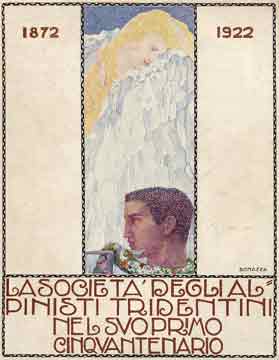
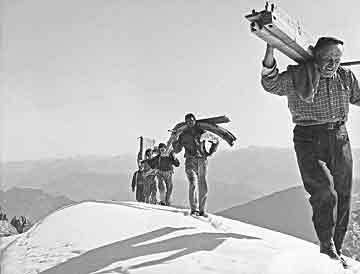
Transportation of parts used to build the Castiglioni Camp
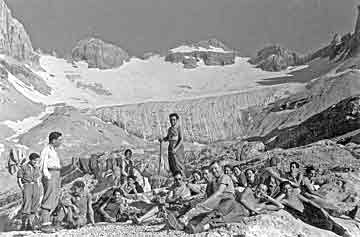
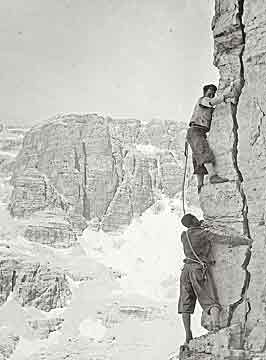
Gino Corrà e Giovanni Strobele sulla Brenta Bassa
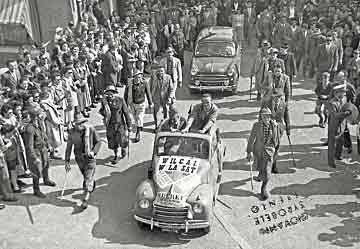
Return to Campiglio of Clemente Maffei “Gueret” after the conquest of Mount Sarmiento in 1956
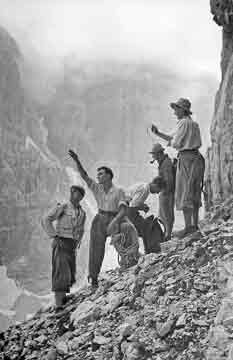
da sin.: G. Corrà, E. Pedrotti, anonimo,
G. Strobele, B. Detassis
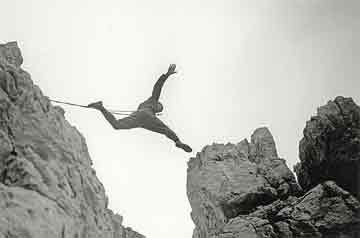
Giorgio Graffer |
|
Claudio Ambrosi
Founded in 1872 on the inspiration of a small group of middle-class people, with time SAT became a mass phenomenon. Its deep roots in daily life - activities ranging from climbing to the arts and sciences, youth work, walking, caving, hiking, recreation, environmental protection, management of mountain facilities and preventive measures - make the association an indispensable part of the life of Trentino.
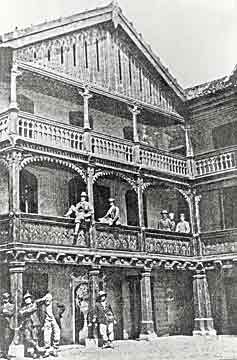
SAT’s founding members at Campiglio:Prospero Marchetti (standing, 3rd from left) and Nepomuceno Bolognini (on balcony, 1st on the left) in the courtyard of the Alpine Establishment of Campiglio (later the Grand Hotel), in about 1875-80.
The SAT was founded about 135 years ago (1872), when Trentino was still part of the Austro-Hungarian empire. The association called itself the Società Alpina del Trentino; however it was dissolved by the Austrian authorities in 1874 because of its members’ irredentist propaganda activity. Within a few months the SAT was reborn along with its present name, Società degli Alpinisti Tridentini.
The years leading up to the Great War coincided with activity aimed at increasing interest in, and also “appropriating”, the mountainous region of Trentino: mountain refuges were built, paths opened, peaks climbed and books published (including the famous Annuari). Every activity was traced back to the irredentist campaign, which finally culminated in the banning of the association and the internment or confinement of the members who had not yet fled to Italy. Many SAT members enlisted in the Italian army to fight Austria. Of these, we remember the most famous: Cesare Battisti.
With the “liberation” of Trentino the association entered a new phase: not only did the SAT join the Italian Climbing Club as an independent section, its membership also grew significantly and changed in social composition: started initially by aristocrats and the wealthy, the association opened its doors to other social classes, who had had their first real taste of high altitudes while fighting as mountain troops during the terrible days of the “White wars”: and these circumstances naturally led to the formation of the first Worker’s Section in the SAT (SOSAT). The widening of its social base meant that the majority of the membership changed from being climbers to hikers, giving a new stimulus to mountain sports: thus began in these years the plan for a network of paths, together with the construction of new refuges and enlargement of the existing ones. Along with the great changes within the SAT came the growth of choral singing; and from the twenties on, mountain songs became the sound track for all their excursions.
During the thirties the association – like all sporting clubs of the time – came under the control of the PNF (Fascist Party) and ceased to be democratic: one result of this was that the leadership of the SAT was no longer elected, but directly appointed by the upper echelons of the fascist party.
After the Second World War the association was able to resume its normal activity: the membership increased constantly over this period, illustrating the widening interest in mountain sports; and this led naturally to an expanding number of volunteers within the association: among the earliest fruits of this was the birth of the first volunteer group to set up an Alpine Rescue service. This SAT initiative took place at Trento in 1952.
When the economic boom opened the path to the mass tourism which still plays an important role in Trentino’s economy, SAT found itself having to deal with all the problems of protecting the environment: the need to safeguard the alpine region – which had always been part of the association’s activity – often came to monopolise discussions within the SAT, steering it towards the search for acceptable answers to the problem of sustainable development for the mountains of Trentino.
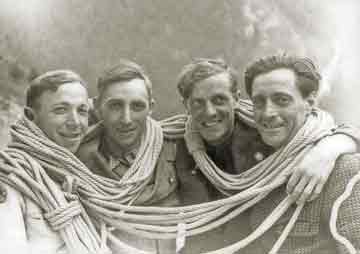
Enrico Giordani, Ulisse Battistata, Rizieri Costazza, Bruno Detassis |
